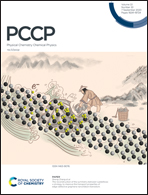Enhancing room-temperature NO2 detection of cobalt phthalocyanine based gas sensor at an ultralow laser exposure†
Abstract
Metal phthalocyanines (MPcs) have attracted great interest in the gas sensing field, but the long recovery time with hard desorption of gas has hindered their further practical application. The combination of cobalt and carboxyl groups increases the electron concentration. Herein, cobalt phthalocyanine (CoPc–COOH) modified with carboxyl groups was prepared and applied to detect nitrogen dioxide (NO2) and its sensing performance at room temperature was determined. These CoPc–COOH nanofibres have demonstrated outstanding recovery performance at an ultralow laser exposure. In particular, UV-Vis and FTIR results indicate no change in the molecular structure of CoPc–COOH powders before and after laser exposure. The enhancement in the recovery properties of the laser-assisted method can be attributed to the generation of electron and hole pairs in the CoPc–COOH nanofibres, where the adsorbed NO2 molecules transformed from NO2− to NO2 by taking one hole with faster desorption. Thus, our study provides a valuable gas sensing recovery mode and mechanism for constructing practical gas sensors.



 Please wait while we load your content...
Please wait while we load your content...